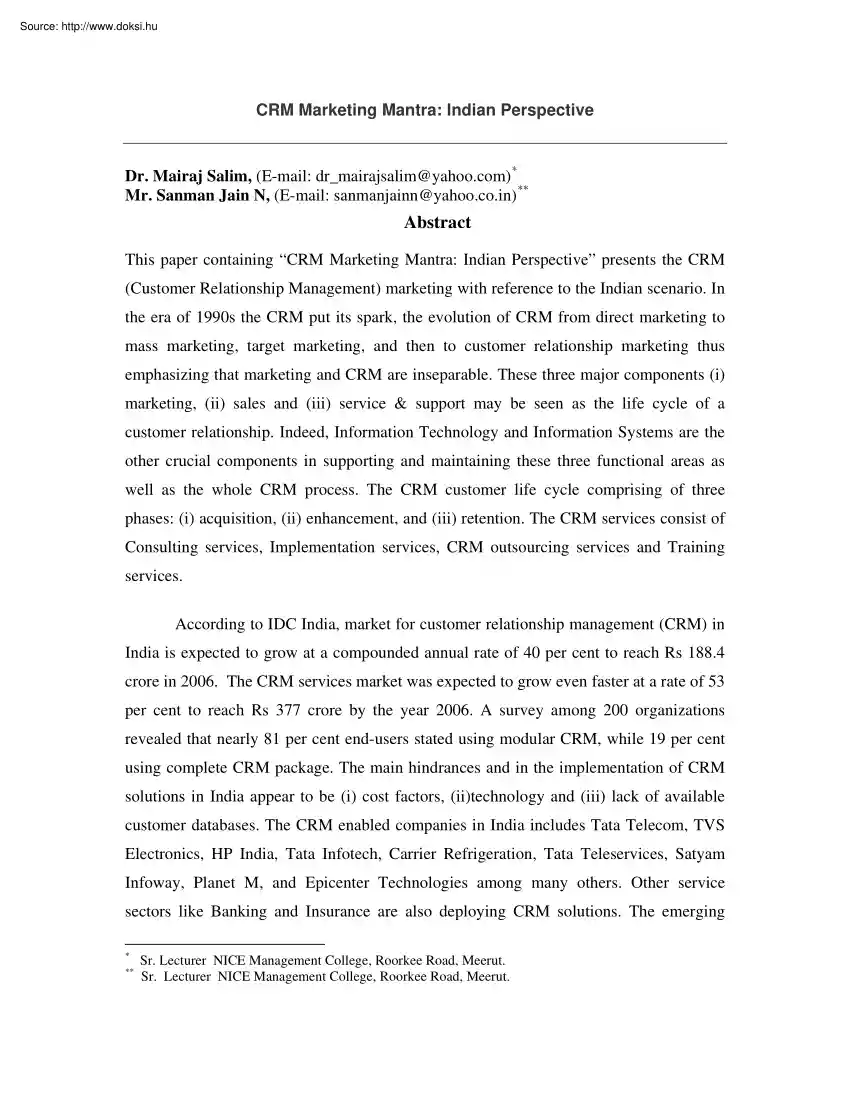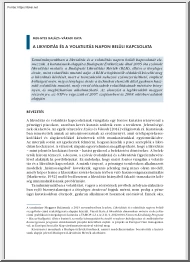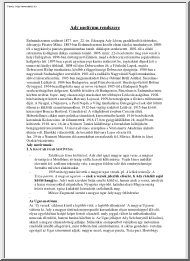Comments
No comments yet. You can be the first!
What did others read after this?
Content extract
CRM Marketing Mantra: Indian Perspective Dr. Mairaj Salim, (E-mail: dr mairajsalim@yahoocom) * Mr. Sanman Jain N, (E-mail: sanmanjainn@yahoocoin) * Abstract This paper containing “CRM Marketing Mantra: Indian Perspective” presents the CRM (Customer Relationship Management) marketing with reference to the Indian scenario. In the era of 1990s the CRM put its spark, the evolution of CRM from direct marketing to mass marketing, target marketing, and then to customer relationship marketing thus emphasizing that marketing and CRM are inseparable. These three major components (i) marketing, (ii) sales and (iii) service & support may be seen as the life cycle of a customer relationship. Indeed, Information Technology and Information Systems are the other crucial components in supporting and maintaining these three functional areas as well as the whole CRM process. The CRM customer life cycle comprising of three phases: (i) acquisition, (ii) enhancement, and (iii) retention. The CRM
services consist of Consulting services, Implementation services, CRM outsourcing services and Training services. According to IDC India, market for customer relationship management (CRM) in India is expected to grow at a compounded annual rate of 40 per cent to reach Rs 188.4 crore in 2006. The CRM services market was expected to grow even faster at a rate of 53 per cent to reach Rs 377 crore by the year 2006. A survey among 200 organizations revealed that nearly 81 per cent end-users stated using modular CRM, while 19 per cent using complete CRM package. The main hindrances and in the implementation of CRM solutions in India appear to be (i) cost factors, (ii)technology and (iii) lack of available customer databases. The CRM enabled companies in India includes Tata Telecom, TVS Electronics, HP India, Tata Infotech, Carrier Refrigeration, Tata Teleservices, Satyam Infoway, Planet M, and Epicenter Technologies among many others. Other service sectors like Banking and Insurance are also
deploying CRM solutions. The emerging * * Sr. Lecturer NICE Management College, Roorkee Road, Meerut Sr. Lecturer NICE Management College, Roorkee Road, Meerut trends in CRM indicate that CRM applications are straddling across business functions to retain, capture and capitalize on customer data i.e integrating all aspects of marketing, business processes and systems by keeping the customer as the core, providing opportunities to Indian organizations. Introduction: Interest 1 in customer relationship management (CRM) began to grow in 1990s. Regardless of the size of an organization, businesses are still motivated to adopt CRM to create and manage the relationships with their customers more effectively. An enhanced relationship with one's customers can ultimately lead to greater customer loyalty and retention and, also, profitability. In addition, the rapid growth of the internet and its associated technologies has greatly increased the opportunities for marketing and has
transformed the way relationships between companies and their customers are managed. Defining CRM (Customer Relationship Management) Newell (2000) 2 defines “CRM is on the identification and delivery of value to each individual customer”. Galbreath and Rogers (1999) 3 explain that CRM is about the management of technology, processes, information resources and people needed to create an environment that allows a business to take a 360-degree view of the customer. These definitions emphasize 4 the importance of viewing CRM as a comprehensive set of strategies for managing those relationships with customers that relate to the overall process of marketing, sales, service, and support within the organization. Moreover, information technology (IT) and information systems (IS) can be used to support and integrate the CRM process to satisfy the needs of the customer. These three components marketing, sales, service, and support may be seen as the life cycle of a customer relationship
that moves from marketing, to sales, to service and support. Indeed, IT and IS are the other crucial components in supporting and maintaining these three functional areas as well as the whole CRM process. These components are: 1. CRM This is the core part of the classification framework that includes general discussion, concept, and managerial aspects of CRM. 2. Marketing Marketing is the function most often associated with CRM CRM is founded in marketing and relationship marketing. The evolution of CRM from direct sales to mass marketing, target marketing, and then to customer relationship marketing thus emphasizing that marketing and CRM are inseparable. 3. Sales The sales function is direct interaction with customers, which makes up CRM. It is important to develop sales strategies at the customer level to build and maintain relationships with customers to achieve revenue goals. With technologies emerging for the sales function, it is possible to make the sales process more
efficient and automated to increase sales. 4. Service and support High quality customer service and support is the key to improving customer retention rates and maintaining a good relationship with customers. In today's highly competitive environment, companies must pay attention to fulfilling the needs of each customer quickly and accurately. Customer satisfaction is hard to win and easy to lose. If customers are not satisfied, they will simply move on to other companies. 5. IT and IS IT and IS play a key role in the development of CRM They can be used to automate and enable some or all CRM processes. Appropriate CRM strategies can be adopted through the assistance of technology, which can manage the data required to understand customers. Moreover, the use of IT and IS can enable the collection of the necessary data to determine the economics of customer acquisition, retention, and life-time value. Advanced technology involves the use of databases, data warehouses, and data
mining to help organizations increase customer retention rates and their own profitability. Phases of CRM 5 There are three phases in CRM. In personal relationships, the level of understanding and intimacy grows over time, as long as both parties are committed to make the relationship work. The same is true in the business world The customer life cycle comprising of 3 phases: (i) acquisition, (ii) enhancement, and (iii) retention. (i). Acquiring new customers – by promoting product/service leadership that pushes performance boundaries with respect to convenience and innovation. Therefore, superior product backed by excellent service. (ii). Enhancing the profitability of existing customers- encourage excellence in crossselling and up-selling This offers greater convenience at low cost (iii). Retaining profitable customers for life- focus on service adaptability Delivering what the customers want. The major segments 6 of CRM services consist of (i) Consulting services, (ii)
Implementation services, (iii) CRM Outsourcing services, and (iv) Training and services Conclusions: CRM Marketing mantra; Indian scenario: 1. The market for customer relationship management (CRM) 7 in India is expected to grow at a compounded annual rate of 40 per cent to reach Rs 188.4 crore in 2006 2. The CRM services market was expected to grow even faster at a rate of 53 per cent to reach Rs 377 crore by the year 2006. 3. IDC India said four out of five companies were spending on modular CRM A survey among 200 organizations revealed that nearly 81 per cent end-users stated that they were using modular CRM, while 19 per cent said they were using complete CRM package. 4. The key business drivers for investing in CRM solutions are customer retention and loyalty and improving cost efficiencies. Another important reason that emerged for CRM adoption was to make sales force management more effective. 5. The main hindrances 8 in the implementation of CRM solutions in India appear to
be: (i) Cost factors: Complete third part CRM solutions (all modules) can be afforded only by very few companies. (ii) Technology (used by many of the companies implementing CRM) is heavily dependent upon the penetration of telecommunications which is very low in India. (iii) Lack of available databases of customers which form a crucial part of CRM Solutions. 6. Although many Indian call centers 9 have come up that cater to international market, there are only a few Indian companies that have actively taken up CRM. The CRM enabled companies include Tata Telecom, TVS Electronics, HP India, Tata Infotech, Carrier Refrigeration, Tata Teleservices, Satyam Infoway, Planet M, and Epicenter Technologies among many others. Recently some of the mobile phone companies in India have started to integrate CRM services to increase the consumer satisfaction. For the big mobile operators, customer care is becoming the differentiator. Other sectors like Banking and Insurance services are also
deploying CRM solutions. ICICI bank and ICICI prudential (insurance) along with several other large banking and insurance companies are adopting CRM solutions. 7. Corporates have realized that efficiently managing existing customer relationships is a low-cost input for cost-effective growth. Clearly, the closer the company is to its own customers, the better it is for the company to stay afloat in a down economy. What tends to happen in a near recession market is competitive firms get more competitive (i.e manage their customer relationships more aggressively) and the least competitive ones phase out. As a result, there is a shakeout that throws up a pool of 'unserviced' or poorly serviced/unattended customers who are most likely to be 'switchers.' This presents an enormous opportunity for companies who have the necessary wherewithal and the operational scalability to efficiently manage these 'floating' customers. These companies then have to make the
right investment related decisions on CRM applications and packages while positioning themselves accordingly in the marketplace. 8. The emerging trends in CRM indicate that CRM applications are straddling across business functions to retain, capture and capitalize on customer data i.e integrating all aspects of business processes and systems by keeping the customer as the core. According to an IDC India report, CRM projects are no longer viewed as stand-alone implementations but are now being increasingly pursued in context of larger business objectives and core strategic agendas. Corporations that realize the true value of their customers in a downturn are the ones that will be better equipped to tide over the slump and jump start, consolidate and thrive again. References: 1 Ling, R., Yen, DC (2001), "Customer relationship management: an analysis framework and implementation strategies", Journal of Computer Information Systems, Vol. 41 No3, pp.82-97 2 Newell, F., 2000,
“Loyaltycom: CRM in the Age of Internet Marketing”, McGraw-Hill, New York, NY. 3 Galbreath, J. and Rogers, T, “Customer Relationship Leadership: a leadership and motivation model for the twenty-first century business”, The TQM Magazine, Volume 11, Number 3, 1999, 161-171. 4 http://www.emeraldinsighcom/insight/view contentservlet?filename=published/emerald 5 http://www.gatewayforindiacom/technology/CRMhtm 6 Kalakota, R., and Robinson, M, (2000), “E-Business: Roadmap for Success”, AddisonWesley, Pearson Education Asia 7 Business Line, Thursday, Feb 20, 2003. 8 http://www.somiitbacin:8080/bitsurvey/uploaded documents/ICT Pilotpdf 9 http://www.gatewayforindiacom/technology/CRMhtm
services consist of Consulting services, Implementation services, CRM outsourcing services and Training services. According to IDC India, market for customer relationship management (CRM) in India is expected to grow at a compounded annual rate of 40 per cent to reach Rs 188.4 crore in 2006. The CRM services market was expected to grow even faster at a rate of 53 per cent to reach Rs 377 crore by the year 2006. A survey among 200 organizations revealed that nearly 81 per cent end-users stated using modular CRM, while 19 per cent using complete CRM package. The main hindrances and in the implementation of CRM solutions in India appear to be (i) cost factors, (ii)technology and (iii) lack of available customer databases. The CRM enabled companies in India includes Tata Telecom, TVS Electronics, HP India, Tata Infotech, Carrier Refrigeration, Tata Teleservices, Satyam Infoway, Planet M, and Epicenter Technologies among many others. Other service sectors like Banking and Insurance are also
deploying CRM solutions. The emerging * * Sr. Lecturer NICE Management College, Roorkee Road, Meerut Sr. Lecturer NICE Management College, Roorkee Road, Meerut trends in CRM indicate that CRM applications are straddling across business functions to retain, capture and capitalize on customer data i.e integrating all aspects of marketing, business processes and systems by keeping the customer as the core, providing opportunities to Indian organizations. Introduction: Interest 1 in customer relationship management (CRM) began to grow in 1990s. Regardless of the size of an organization, businesses are still motivated to adopt CRM to create and manage the relationships with their customers more effectively. An enhanced relationship with one's customers can ultimately lead to greater customer loyalty and retention and, also, profitability. In addition, the rapid growth of the internet and its associated technologies has greatly increased the opportunities for marketing and has
transformed the way relationships between companies and their customers are managed. Defining CRM (Customer Relationship Management) Newell (2000) 2 defines “CRM is on the identification and delivery of value to each individual customer”. Galbreath and Rogers (1999) 3 explain that CRM is about the management of technology, processes, information resources and people needed to create an environment that allows a business to take a 360-degree view of the customer. These definitions emphasize 4 the importance of viewing CRM as a comprehensive set of strategies for managing those relationships with customers that relate to the overall process of marketing, sales, service, and support within the organization. Moreover, information technology (IT) and information systems (IS) can be used to support and integrate the CRM process to satisfy the needs of the customer. These three components marketing, sales, service, and support may be seen as the life cycle of a customer relationship
that moves from marketing, to sales, to service and support. Indeed, IT and IS are the other crucial components in supporting and maintaining these three functional areas as well as the whole CRM process. These components are: 1. CRM This is the core part of the classification framework that includes general discussion, concept, and managerial aspects of CRM. 2. Marketing Marketing is the function most often associated with CRM CRM is founded in marketing and relationship marketing. The evolution of CRM from direct sales to mass marketing, target marketing, and then to customer relationship marketing thus emphasizing that marketing and CRM are inseparable. 3. Sales The sales function is direct interaction with customers, which makes up CRM. It is important to develop sales strategies at the customer level to build and maintain relationships with customers to achieve revenue goals. With technologies emerging for the sales function, it is possible to make the sales process more
efficient and automated to increase sales. 4. Service and support High quality customer service and support is the key to improving customer retention rates and maintaining a good relationship with customers. In today's highly competitive environment, companies must pay attention to fulfilling the needs of each customer quickly and accurately. Customer satisfaction is hard to win and easy to lose. If customers are not satisfied, they will simply move on to other companies. 5. IT and IS IT and IS play a key role in the development of CRM They can be used to automate and enable some or all CRM processes. Appropriate CRM strategies can be adopted through the assistance of technology, which can manage the data required to understand customers. Moreover, the use of IT and IS can enable the collection of the necessary data to determine the economics of customer acquisition, retention, and life-time value. Advanced technology involves the use of databases, data warehouses, and data
mining to help organizations increase customer retention rates and their own profitability. Phases of CRM 5 There are three phases in CRM. In personal relationships, the level of understanding and intimacy grows over time, as long as both parties are committed to make the relationship work. The same is true in the business world The customer life cycle comprising of 3 phases: (i) acquisition, (ii) enhancement, and (iii) retention. (i). Acquiring new customers – by promoting product/service leadership that pushes performance boundaries with respect to convenience and innovation. Therefore, superior product backed by excellent service. (ii). Enhancing the profitability of existing customers- encourage excellence in crossselling and up-selling This offers greater convenience at low cost (iii). Retaining profitable customers for life- focus on service adaptability Delivering what the customers want. The major segments 6 of CRM services consist of (i) Consulting services, (ii)
Implementation services, (iii) CRM Outsourcing services, and (iv) Training and services Conclusions: CRM Marketing mantra; Indian scenario: 1. The market for customer relationship management (CRM) 7 in India is expected to grow at a compounded annual rate of 40 per cent to reach Rs 188.4 crore in 2006 2. The CRM services market was expected to grow even faster at a rate of 53 per cent to reach Rs 377 crore by the year 2006. 3. IDC India said four out of five companies were spending on modular CRM A survey among 200 organizations revealed that nearly 81 per cent end-users stated that they were using modular CRM, while 19 per cent said they were using complete CRM package. 4. The key business drivers for investing in CRM solutions are customer retention and loyalty and improving cost efficiencies. Another important reason that emerged for CRM adoption was to make sales force management more effective. 5. The main hindrances 8 in the implementation of CRM solutions in India appear to
be: (i) Cost factors: Complete third part CRM solutions (all modules) can be afforded only by very few companies. (ii) Technology (used by many of the companies implementing CRM) is heavily dependent upon the penetration of telecommunications which is very low in India. (iii) Lack of available databases of customers which form a crucial part of CRM Solutions. 6. Although many Indian call centers 9 have come up that cater to international market, there are only a few Indian companies that have actively taken up CRM. The CRM enabled companies include Tata Telecom, TVS Electronics, HP India, Tata Infotech, Carrier Refrigeration, Tata Teleservices, Satyam Infoway, Planet M, and Epicenter Technologies among many others. Recently some of the mobile phone companies in India have started to integrate CRM services to increase the consumer satisfaction. For the big mobile operators, customer care is becoming the differentiator. Other sectors like Banking and Insurance services are also
deploying CRM solutions. ICICI bank and ICICI prudential (insurance) along with several other large banking and insurance companies are adopting CRM solutions. 7. Corporates have realized that efficiently managing existing customer relationships is a low-cost input for cost-effective growth. Clearly, the closer the company is to its own customers, the better it is for the company to stay afloat in a down economy. What tends to happen in a near recession market is competitive firms get more competitive (i.e manage their customer relationships more aggressively) and the least competitive ones phase out. As a result, there is a shakeout that throws up a pool of 'unserviced' or poorly serviced/unattended customers who are most likely to be 'switchers.' This presents an enormous opportunity for companies who have the necessary wherewithal and the operational scalability to efficiently manage these 'floating' customers. These companies then have to make the
right investment related decisions on CRM applications and packages while positioning themselves accordingly in the marketplace. 8. The emerging trends in CRM indicate that CRM applications are straddling across business functions to retain, capture and capitalize on customer data i.e integrating all aspects of business processes and systems by keeping the customer as the core. According to an IDC India report, CRM projects are no longer viewed as stand-alone implementations but are now being increasingly pursued in context of larger business objectives and core strategic agendas. Corporations that realize the true value of their customers in a downturn are the ones that will be better equipped to tide over the slump and jump start, consolidate and thrive again. References: 1 Ling, R., Yen, DC (2001), "Customer relationship management: an analysis framework and implementation strategies", Journal of Computer Information Systems, Vol. 41 No3, pp.82-97 2 Newell, F., 2000,
“Loyaltycom: CRM in the Age of Internet Marketing”, McGraw-Hill, New York, NY. 3 Galbreath, J. and Rogers, T, “Customer Relationship Leadership: a leadership and motivation model for the twenty-first century business”, The TQM Magazine, Volume 11, Number 3, 1999, 161-171. 4 http://www.emeraldinsighcom/insight/view contentservlet?filename=published/emerald 5 http://www.gatewayforindiacom/technology/CRMhtm 6 Kalakota, R., and Robinson, M, (2000), “E-Business: Roadmap for Success”, AddisonWesley, Pearson Education Asia 7 Business Line, Thursday, Feb 20, 2003. 8 http://www.somiitbacin:8080/bitsurvey/uploaded documents/ICT Pilotpdf 9 http://www.gatewayforindiacom/technology/CRMhtm





 Just like you draw up a plan when you’re going to war, building a house, or even going on vacation, you need to draw up a plan for your business. This tutorial will help you to clearly see where you are and make it possible to understand where you’re going.
Just like you draw up a plan when you’re going to war, building a house, or even going on vacation, you need to draw up a plan for your business. This tutorial will help you to clearly see where you are and make it possible to understand where you’re going.